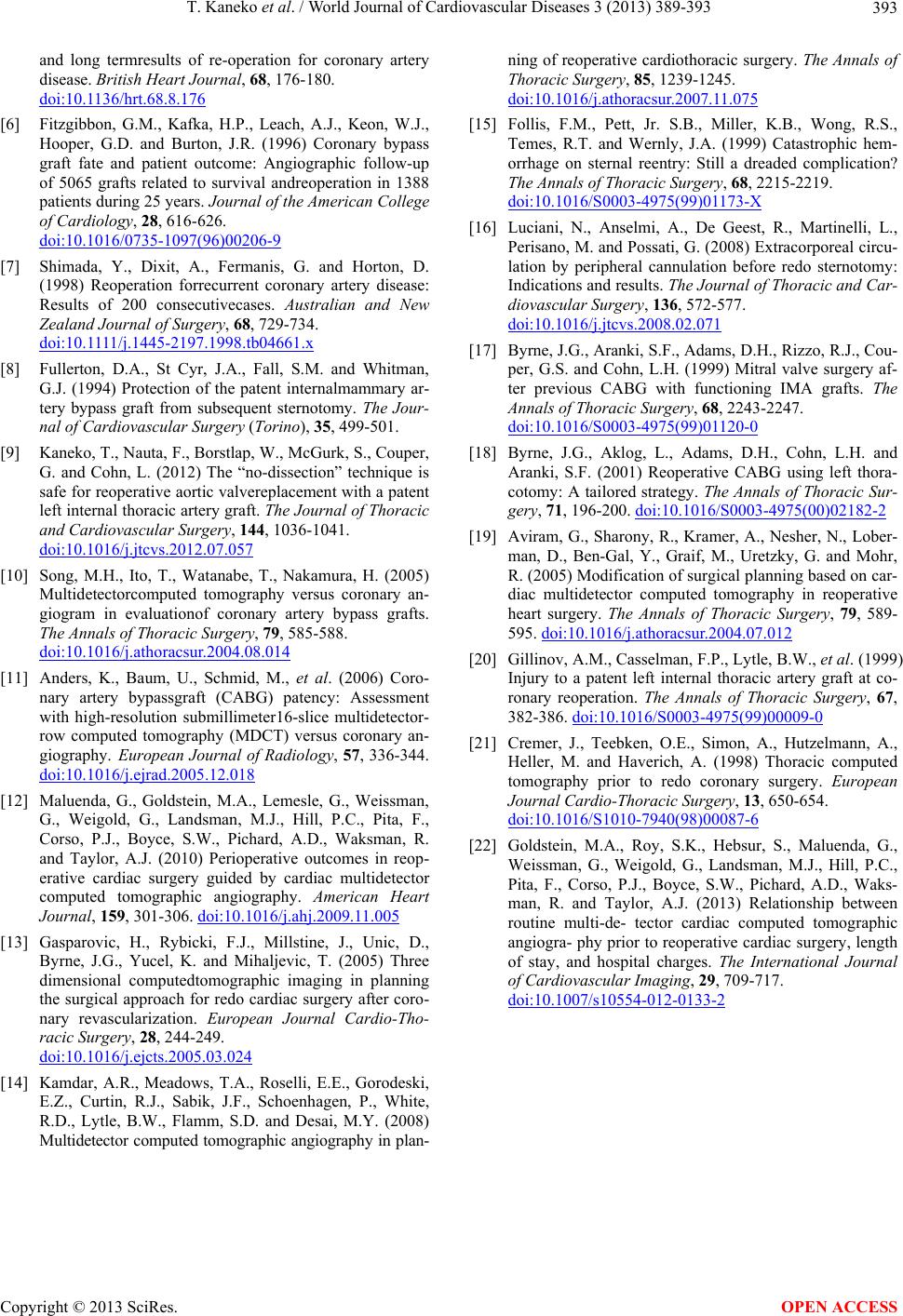
T. Kaneko et al. / World Journal of Cardiovascular Diseases 3 (2013) 389-393
Copyright © 2013 SciRes.
393
OPEN ACCESS
and long termresults of re-operation for coronary artery
disease. British Heart Journal, 68, 176-180.
doi:10.1136/hrt.68.8.176
[6] Fitzgibbon, G.M., Kafka, H.P., Leach, A.J., Keon, W.J.,
Hooper, G.D. and Burton, J.R. (1996) Coronary bypass
graft fate and patient outcome: Angiographic follow-up
of 5065 grafts related to survival andreoperation in 1388
patients during 25 years. Journal of the American College
of Cardiology, 28, 616-626.
doi:10.1016/0735-1097(96)00206-9
[7] Shimada, Y., Dixit, A., Fermanis, G. and Horton, D.
(1998) Reoperation forrecurrent coronary artery disease:
Results of 200 consecutivecases. Australian and New
Zealand Journal of Surgery, 68, 729-734.
doi:10.1111/j.1445-2197.1998.tb04661.x
[8] Fullerton, D.A., St Cyr, J.A., Fall, S.M. and Whitman,
G.J. (1994) Protection of the patent internalmammary ar-
tery bypass graft from subsequent sternotomy. The Jour-
nal of Cardiovascular Surgery (Torino), 35, 499-501.
[9] Kaneko, T., Nauta, F., Borstlap, W., McGurk, S., Couper,
G. and Cohn, L. (2012) The “no-dissection” technique is
safe for reoperative aortic valvereplacement with a patent
left internal thoracic artery graft. The Journal of Thoracic
and Cardiovascular Surgery, 144, 1036-1041.
doi:10.1016/j.jtcvs.2012.07.057
[10] Song, M.H., Ito, T., Watanabe, T., Nakamura, H. (2005)
Multidetectorcomputed tomography versus coronary an-
giogram in evaluationof coronary artery bypass grafts.
The Annals of Thoracic Surgery, 79, 585-588.
doi:10.1016/j.athoracsur.2004.08.014
[11] Anders, K., Baum, U., Schmid, M., et al. (2006) Coro-
nary artery bypassgraft (CABG) patency: Assessment
with high-resolution submillimeter16-slice multidetector-
row computed tomography (MDCT) versus coronary an-
giography. European Journal of Radiology, 57, 336-344.
doi:10.1016/j.ejrad.2005.12.018
[12] Maluenda, G., Goldstein, M.A., Lemesle, G., Weissman,
G., Weigold, G., Landsman, M.J., Hill, P.C., Pita, F.,
Corso, P.J., Boyce, S.W., Pichard, A.D., Waksman, R.
and Taylor, A.J. (2010) Perioperative outcomes in reop-
erative cardiac surgery guided by cardiac multidetector
computed tomographic angiography. American Heart
Journal, 159, 301-306. doi:10.1016/j.ahj.2009.11.005
[13] Gasparovic, H., Rybicki, F.J., Millstine, J., Unic, D.,
Byrne, J.G., Yucel, K. and Mihaljevic, T. (2005) Three
dimensional computedtomographic imaging in planning
the surgical approach for redo cardiac surgery after coro-
nary revascularization. European Journal Cardio-Tho-
racic Surgery, 28, 244-249.
doi:10.1016/j.ejcts.2005.03.024
[14] Kamdar, A.R., Meadows, T.A., Roselli, E.E., Gorodeski,
E.Z., Curtin, R.J., Sabik, J.F., Schoenhagen, P., White,
R.D., Lytle, B.W., Flamm, S.D. and Desai, M.Y. (2008)
Multidetector computed tomographic angiography in plan-
ning of reoperative cardiothoracic surgery. The Annals of
Thoracic Surgery, 85, 1239-1245.
doi:10.1016/j.athoracsur.2007.11.075
[15] Follis, F.M., Pett, Jr. S.B., Miller, K.B., Wong, R.S.,
Temes, R.T. and Wernly, J.A. (1999) Catastrophic hem-
orrhage on sternal reentry: Still a dreaded complication?
The Annals of Thoracic Surgery, 68, 2215-2219.
doi:10.1016/S0003-4975(99)01173-X
[16] Luciani, N., Anselmi, A., De Geest, R., Martinelli, L.,
Perisano, M. and Possati, G. (2008) Extracorporeal circu-
lation by peripheral cannulation before redo sternotomy:
Indications and results. The Journal of Thoracic and Car-
diovascular Surgery, 136, 572-577.
doi:10.1016/j.jtcvs.2008.02.071
[17] Byrne, J.G., Aranki, S.F., Adams, D.H., Rizzo, R.J., Cou-
per, G.S. and Cohn, L.H. (1999) Mitral valve surgery af-
ter previous CABG with functioning IMA grafts. The
Annals of Thoracic Surgery, 68, 2243-2247.
doi:10.1016/S0003-4975(99)01120-0
[18] Byrne, J.G., Aklog, L., Adams, D.H., Cohn, L.H. and
Aranki, S.F. (2001) Reoperative CABG using left thora-
cotomy: A tailored strategy. The Annals of Thoracic Sur-
gery, 71, 196-200. doi:10.1016/S0003-4975(00)02182-2
[19] Aviram, G., Sharony, R., Kramer, A., Nesher, N., Lober-
man, D., Ben-Gal, Y., Graif, M., Uretzky, G. and Mohr,
R. (2005) Modification of surgical planning based on car-
diac multidetector computed tomography in reoperative
heart surgery. The Annals of Thoracic Surgery, 79, 589-
595. doi:10.1016/j.athoracsur.2004.07.012
[20] Gillinov, A.M., Casselman, F.P., Lytle, B.W., et al. (1999)
Injury to a patent left internal thoracic artery graft at co-
ronary reoperation. The Annals of Thoracic Surgery, 67,
382-386. doi:10.1016/S0003-4975(99)00009-0
[21] Cremer, J., Teebken, O.E., Simon, A., Hutzelmann, A.,
Heller, M. and Haverich, A. (1998) Thoracic computed
tomography prior to redo coronary surgery. European
Journal Cardio-Thoracic Surgery, 13, 650-654.
doi:10.1016/S1010-7940(98)00087-6
[22] Goldstein, M.A., Roy, S.K., Hebsur, S., Maluenda, G.,
Weissman, G., Weigold, G., Landsman, M.J., Hill, P.C.,
Pita, F., Corso, P.J., Boyce, S.W., Pichard, A.D., Waks-
man, R. and Taylor, A.J. (2013) Relationship between
routine multi-de- tector cardiac computed tomographic
angiogra- phy prior to reoperative cardiac surgery, length
of stay, and hospital charges. The International Journal
of Cardiovascular Imaging, 29, 709-717.
doi:10.1007/s10554-012-0133-2